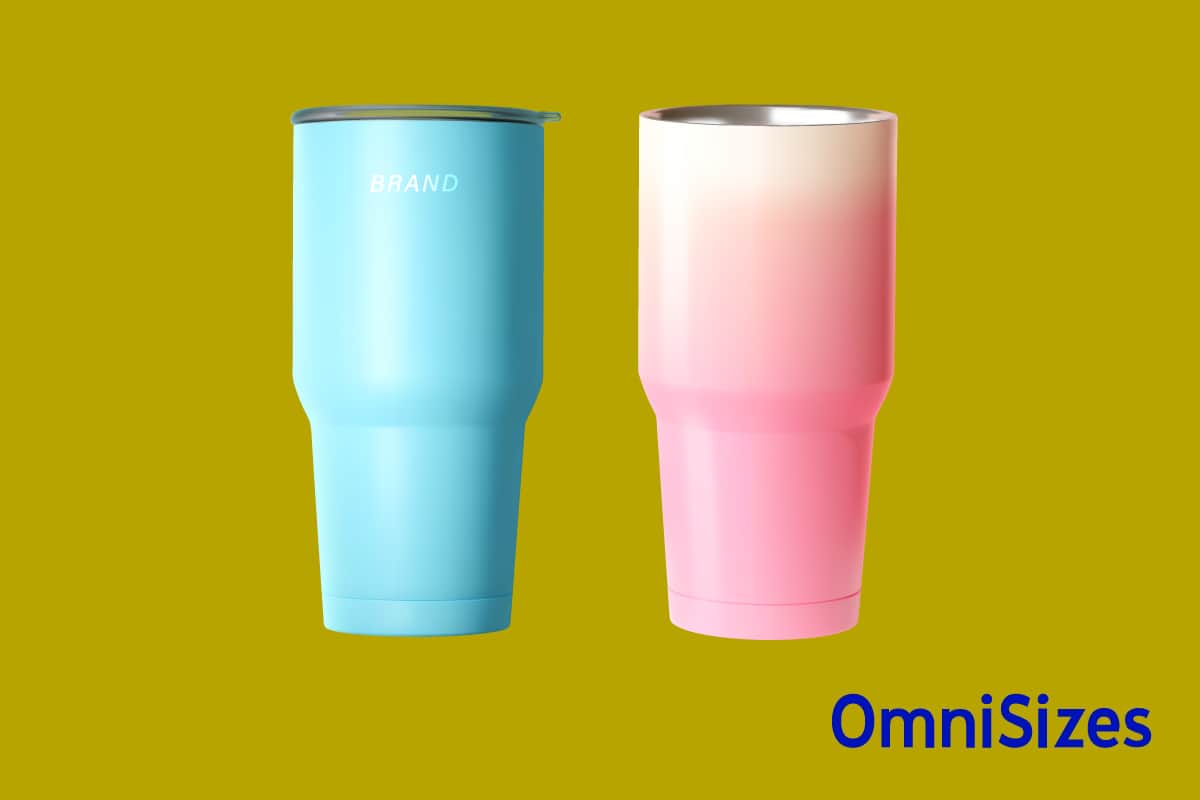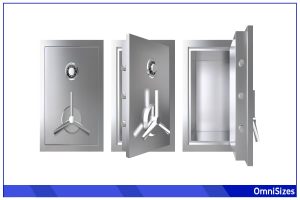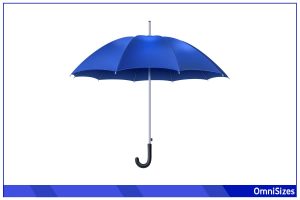Tumblers are everyday times that come in a variety of sizes. The concept of “tumbler size” reflects how we enjoy our favorite beverages, from a morning coffee to an evening drink. So, what sizes do tumblers come in?
Common tumbler sizes range from small 8-ounce (2.5 × 3.5 inches) to medium 16-ounce (3.0 × 6.0 inches), and large 24-ounce sizes (3.5 × 7.5 inches). While larger tumblers can hold more, finding a spot to for them in your car or bike can be troublesome.

This brief guide will cover everything from the basics of tumbler dimensions to maintaining this beverage vessel.
Why Does Tumbler Size Matter?
Before learning about different tumbler sizes, it’s important to first establish why tumbler size even matters.
1. Impact on Beverage Temperature
Larger tumblers often have more insulation, keeping drinks at the desired temperature longer. Smaller tumblers, on the other hand, are great for quick drinks that don’t need long-term temperature maintenance.
2. Convenience and Portability
A smaller tumbler is easy to carry and fits in most cup holders, making it ideal for commutes. Larger sizes are better suited for longer durations where frequent refills aren’t feasible, such as during long road trips or extended work periods.
3. Suitability for Different Beverages
Different beverages are best enjoyed in specific tumbler sizes. For instance, a small tumbler is perfect for a shot of espresso, while a larger one is better for smoothies or iced coffee.
4. Health and Hydration
Larger tumblers encourage more fluid intake, which can keep you hydrated during physical activities or hot weather. Smaller tumblers are suitable for stronger or more flavorful drinks where moderation is key.
Types of Tumblers
A quick online search will yield a wide variety of tumbler types, including glass, plastic, and insulated tumblers.
1. Glass Tumblers
Glass tumblers are known for their elegant and transparent appearance. They are appreciated for not retaining flavors and providing a pure beverage experience. However, their fragility is a drawback, as they can break easily.
2. Plastic Tumblers
Plastic tumblers offer durability and a variety of colorful designs. They are ideal for casual settings, outdoor events, and especially for children due to their shatter-resistant nature. While they are lightweight, some types may retain flavors and odors.
3. Stainless Steel Tumblers
Stainless steel tumblers are robust and often come with insulation. They excel in keeping drinks at the desired temperature for extended periods. The downside is their weight and cost, as they are generally heavier and more expensive than other types.
Common Tumbler Sizes and Capacities
Tumbler sizes are typically measured in ounces (oz) and by dimensions (height × diameter). Common sizes include small, medium, large, and extra large.
1. Small Tumblers
Small tumblers are easy to handle and perfect for a quick drink. Their compact size fits easily in most spaces, including car cup holders, making them convenient for travel.
- Capacity: 8-12 oz (237-355 ml)
- Common Measurements: Approx. 4 × 2.5 inches (10 × 6.35 cm)
- Best for: Espresso, small servings of juice, or children’s drinks. They are compact and fit easily in most spaces, perfect for quick consumption.
2. Medium Tumblers
Medium-sized tumblers are the most versatile. This size strikes a balance between holding enough beverage to satisfy and still being portable.
- Capacity: 16-20 oz (473-591 ml)
- Common Measurements: Approx. 6 × 3 inches (15 × 7.62 cm)
- Best for: Standard servings of coffee, tea, smoothies, and soft drinks. This size balances sufficient capacity for enjoyment and portability.
3. Large Tumblers
Large tumblers are great for those who prefer fewer refills throughout the day. These tumblers are especially useful during workouts, long commutes, or in the office.
- Capacity: 24-32 oz (710-946 ml)
- Common Measurements: Approx. 7.5 × 3.5 inches (19 × 8.89 cm)
- Best for: Water, iced coffee, or large smoothies. Preferred for extended periods without refills, like workouts or long commutes.
4. Extra-Large Tumblers
Extra-large tumblers cater to those who need large amounts of fluids. They are also useful for parties or gatherings where large servings are needed.
- Capacity: 32 oz and above (946 ml and more)
- Common Measurements: Vary widely, often exceeding 8 × 4 inches (20 × 10 cm)
- Best for: Suitable for athletes, outdoor activities, or gatherings where large servings are essential.
Best Tumbler Picks
| Name | Tumbler Size | Features |
| BLUEPOLAR Glass Water Tumbler with Straw and Lid | Medium (13 oz) |
|
| Hydro Flask All Around Stainless Steel Tumbler | Varies (12 to 28 oz) |
|
| REDUCE 24 oz Travel Tumbler | Large (24 oz) |
|
| Simple Modern Wine Tumbler | Small (12 oz) |
|
| Coleman Brew Vacuum-Insulated Stainless Steel Tumbler | Medium (20 oz) |
|
Tips for Caring for Your Tumbler
Proper care of your tumbler extends its life. From cleaning to storage, each type of tumbler needs specific care.
1. Regular Cleaning
- Rinse your tumbler after each use to prevent residue buildup.
- For a deeper clean, use warm, soapy water. Dish soap works well for most materials.
- Avoid abrasive sponges on stainless steel and glass to prevent scratches.
- For stubborn stains, a mixture of baking soda and water can be effective.
2. Dishwasher Safety
- Check the manufacturer’s instructions to see if your tumbler is dishwasher safe.
- Glass and high-quality plastic tumblers are often dishwasher safe, but the heat can damage some plastic types.
- Stainless steel tumblers are usually best washed by hand to maintain their insulation properties.
3. Handling Odors
- To eliminate odors, soak the tumbler in a mixture of vinegar and water.
- For plastic tumblers, leaving them in a well-ventilated area after washing can help disperse any lingering smells.
4. Avoiding Damage
- Don’t use glass tumblers for hot beverages unless they are tempered.
- Avoid dropping or knocking your tumblers, especially ceramic and glass types.
- Do not expose plastic tumblers to extreme temperatures, as this can cause warping.
5. Maintaining Insulated Tumblers
- Do not freeze or boil insulated tumblers, as extreme temperatures can damage the insulation.
- Occasionally check the seal and lid for wear and tear.






